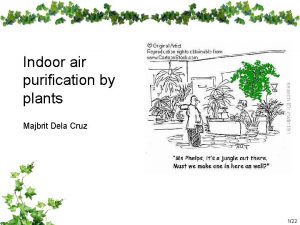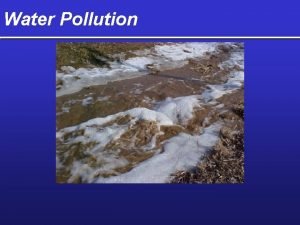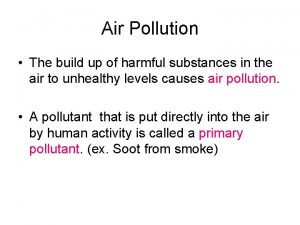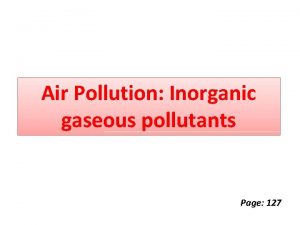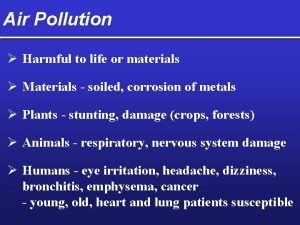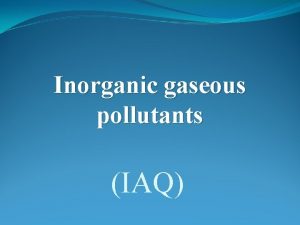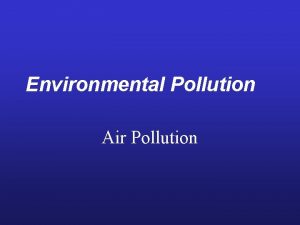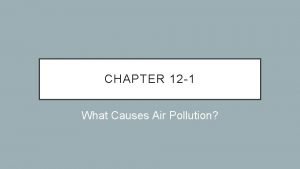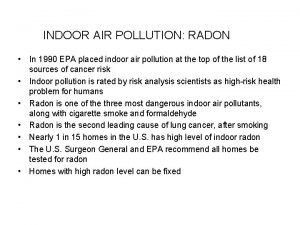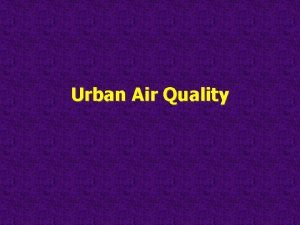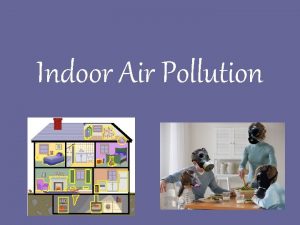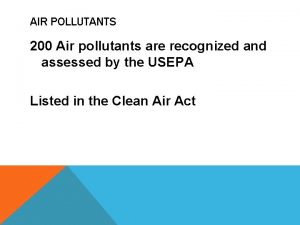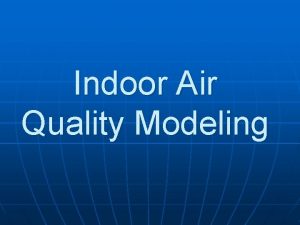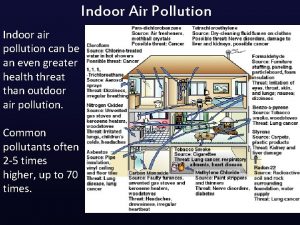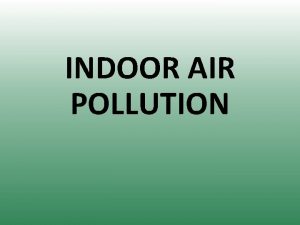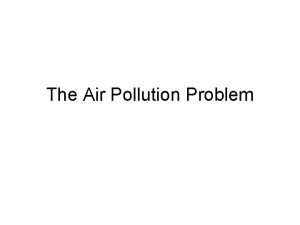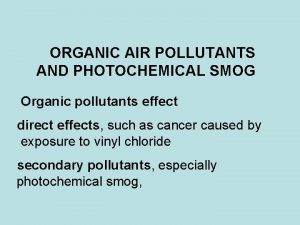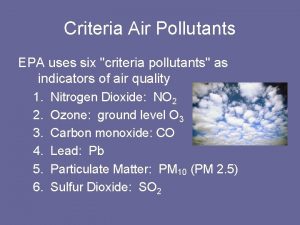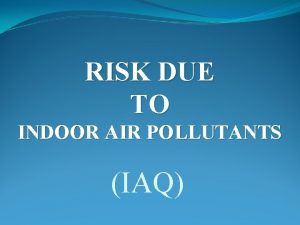European data on exposure to indoor air pollutants


















- Slides: 18

European data on exposure to indoor air pollutants and their determinants Sean Semple University of Aberdeen INTERA Stakeholder Workshop 18 th of November 2011 Brussels

Work Package 1 • “Determine the main parameters influencing exposure (to each indoor air pollutant in our list) (within the environments we define) (taking in to account the various sub-populations we may be interested in)”… • 4 main sub-tasks – – Initial brain-storming session involving all partners Comprehensive literature review Extraction of parameters from existing IAQ models Generation of matrix of influencing parameters for each pollutant - with some semi-quantitative rating of importance INTERA Stakeholder Workshop 18 th of November 2011 Brussels

Narrowing the number of pollutants • Particulates – PM 10, PM 2. 5 -10, PM 2. 5 and Black smoke, PNC • • • Benzene, Naphthalene, Toluene, Xylene Formaldehyde, acetaldehyde CO CO 2 Radon NO, NO 2 Mould, endotoxin, bioaerosols Flame retardants (PBDE), plasticizers Pesticides, insecticides Metals, Pb, As… Fibres, MMMF, Asbestos… Environmental tobacco smoke contains 4000+ chemicals alone INTERA Stakeholder Workshop 18 th of November 2011 Brussels

What we focussed on. . . • Limit to chemical pollutants – Not particulates – Not biologicals • • Benzene, Toluene, Xylene (BTX) Formaldehyde, acetaldehyde Radon Nicotine CO/CO 2 NO 2 SVOCs INTERA Stakeholder Workshop 18 th of November 2011 Brussels

Literature search • • A search of Ovid Medline was performed (1950 to September Week 2 2010), using the following search terms: Indoor Air Pollution (7407 hits) With: • • • Homes (930 hits) limits applied - (680 hits) Domestic (336 hits) limits applied -(239 hits) Determinants (102 hits) limits applied -(87 hits) • The results were limited to studies undertaken since 1995, reporting some measurement data of at least one air pollutant within the European Union with full text published in English, and involving human beings. INTERA Stakeholder Workshop 18 th of November 2011 Brussels

Literature search • 195 publication titles were examined, 65 were discarded as not relevant to the study themes. • The remaining 130 publications were separated into three categories: 46 in ‘chemical’; 12 in ‘particulates’; and 72 in ‘biological’. • From INTERA project meetings in February, May and September, together with input across the 3 webinars held in June-July 2010, scope was identified as consumer product chemicals within domestic homes. • As a result the 84 identified publications classified as examining either biological or solely particulate exposure data were not included in the literature review. INTERA Stakeholder Workshop 18 th of November 2011 Brussels

IAQ models search • • Examined the ‘grey’ literature and accessing literature and project reports available from academic institutions, funding bodies and other organizations with a research or consumer interest in indoor air quality (IAQ). List of IAQ models identified by the INTERA project team, Google and Google Scholar search and then each specific source was checked for additional links, employing a ‘snowball’ technique. ‘snowball’ starting points were the US EPA indoor air webpage, the book “Exposure Analysis” (edited by Ott, Steinemann and Wallace, 2006, page 459), reports from the HEIMSTA project, and specific papers where indoor models have been used such as EXPOLIS. INTERA Stakeholder Workshop 18 th of November 2011 Brussels

IAQ models search • A total of 27 currently used indoor air quality modelling methods are presented in the report • These range from broad risk characterisation models through to more specific exposure modelling systems for specific tasks. INTERA Stakeholder Workshop 18 th of November 2011 Brussels

Main exposure sources identified • • Combustion sources (fires, cookers, boilers, candles, cigarettes) Furnishings Building materials (floors, paints, walls, insulation) Animals (companion animals/pests) and plants Consumer products (deodorants, perfumes, creams, air fresheners, insecticides) Toys (dermal and ingestion exposure in particular) Outdoor air Outdoor contamination on clothes (insecticides, workplace takehome exposure) INTERA Stakeholder Workshop 18 th of November 2011 Brussels

Determinants of exposure • Conceptual model of exposure • Exposure = time x concentration • Time activity – Time indoors – Activities and behaviours • Concentration – – Emission/generation from indoor sources Transmission from outdoor to indoor Removal by ventilation systems Mixing INTERA Stakeholder Workshop 18 th of November 2011 Brussels

Determinants of concentrations • Transmission – Outdoor air quality; I: O ratios • Removal and mixing – Ventilation system • Natural/mechanical/air conditioning • Emission/generation – Use of indoor combustion sources (heating, cooking, smoking) – Use and storage of consumer products (air fresheners, sprays, perfumes, paints etc) – Building material, furnishings, decorations – Moist structures: plants, animals INTERA Stakeholder Workshop 18 th of November 2011 Brussels

INTERA concentration matrix + some influence ++ considerable determinant of exposure +++ the primary concentration determinant for that pollutant Notes • Combustion sources include: fires, cookers, boilers, candles and tobacco products • Consumer products include: sprays, air fresheners, perfumes, paints and activities such as vacuuming/DIY etc • Building materials and furnishings include: flooring, wood, laminate and MDF furnishings, insulation material. • Ventilation will play a major role for most particulate and vapour concentrations: a substantial route of uptake for PBDE and insecticides will be by ingestion via hand-mouth so while ventilation will be important for determining the concentration in a given space, much of the exposure to these agents will come via the ingestion route. • Animals, plants and moist structures play an indirect role in determining insecticide concentrations in that their presence influences the probability and frequency of use. INTERA Stakeholder Workshop 18 th of November 2011 Brussels

Timeline • • Webinar involving invited experts to comment on concepts 29/06/10 1 st draft delivered 20/12/10 – Reviewed by INTERA team – Reviewed by CEFIC – Comments • • • Incorporate dermal/ingestion exposures Summarise exposure data in excel tables 2 nd draft completed 16/02/11 – Reviewed by INTERA team • • • Finalised 28/02/11 Published online 03/03/11 Data on exposures incorporated in to WP 2 INTERA Stakeholder Workshop 18 th of November 2011 Brussels

Available on INTERA website INTERA Stakeholder Workshop 18 th of November 2011 Brussels

WP 1 report • A review of the scientific literature of inhalation, dermal and ingestion exposures to indoor chemical pollutants in domestic environments – EU studies within the past 15 years • • • The review additionally identifies existing and developing indoor pollutant modelling methods across all exposure routes 57 scientific papers identified and summarised 29 indoor pollutant modelling methods summarised Excel tables of exposure data relating to measured levels of VOCs, nicotine, PAHs, PBDEs, aldehydes, NO 2, radon, CO 2, CO Exposure matrix for main pollutants/determinants INTERA Stakeholder Workshop 18 th of November 2011 Brussels

Example of extracted exposure data INTERA Stakeholder Workshop 18 th of November 2011 Brussels

Conclusions • Limited amount of data on concentrations of (or exposure to) air pollutants in home settings across the EU – 57 papers in 16 years across 27 countries. . . • Data tend to be collected from populations with health conditions/undergoing interventions- rarely representative or random sample data • Dermal and ingestion exposure data in homes sparse • Determinants of inhalation exposure well understood and described in 27+ IAQ models • Exposure data fed in to INTERA KMS and used in the computational platform. . . INTERA Stakeholder Workshop 18 th of November 2011 Brussels

Acknowledgements • INTERA Team – Arja Asikainen, Karen Galea, Alberto Gotti, Denis Sarigiannis, Araceli Sanchez Jimenez, Katleen De Brouwere, Rudi Torfs, Arnout Standaert, Matti Jantunen, Spyros Karakitsios, Carole Garden • CEFIC LRI INTERA Stakeholder Workshop 18 th of November 2011 Brussels
 Indoor air pollution sources
Indoor air pollution sources Primary pollutants and secondary pollutants
Primary pollutants and secondary pollutants Primary pollutants and secondary pollutants
Primary pollutants and secondary pollutants What is secondary pollutant
What is secondary pollutant Managing economic exposure and translation exposure
Managing economic exposure and translation exposure Eksposur translasi adalah
Eksposur translasi adalah Transaction exposure and economic exposure
Transaction exposure and economic exposure Managing economic exposure and translation exposure
Managing economic exposure and translation exposure Inorganic gaseous pollutants of air
Inorganic gaseous pollutants of air What is secondary pollutant
What is secondary pollutant Inorganic gases
Inorganic gases What are the secondary air pollutants
What are the secondary air pollutants Major air pollutants
Major air pollutants Air pollutants
Air pollutants Indoor air pollution examples
Indoor air pollution examples Radon indoor air pollution
Radon indoor air pollution Prevention of indoor air pollution
Prevention of indoor air pollution Air higroskopis adalah
Air higroskopis adalah Secondary pollutants examples
Secondary pollutants examples
